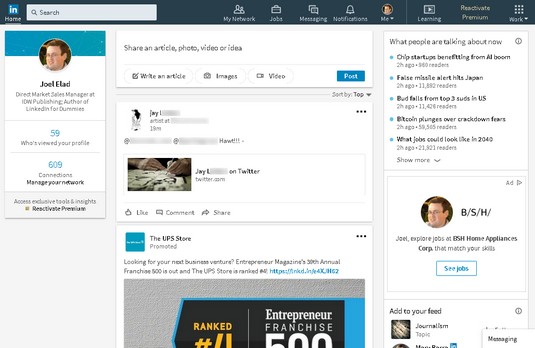Similar to other social media sites, LinkedIn allows you to stay connected via the news feed. Imagine if you read a newspaper that showed you only articles that mattered to you. (For that matter, for many of you, imagine the days you might have read a newspaper.) Customized news is ubiquitous on the Internet nowadays, and on LinkedIn, it’s called your LinkedIn news feed. The LinkedIn news feed shows you various articles.
The LinkedIn news feed shows you various articles.
Your news feed is already part of the LinkedIn experience, taking up the center column of your home screen, below the box where you share an update, photo, or post. When you bring up LinkedIn in your web browser, you see news articles and updates.
 The LinkedIn news feed shows you various articles.
The LinkedIn news feed shows you various articles.First off, let’s talk about the different elements that make up your news feed. You can expect to see these types of elements:
- Network updates: Your activity on LinkedIn and the events of your LinkedIn network are considered to be news. On occasion LinkedIn will give you updates on what’s occurred in your network, or give you updates when LinkedIn members are celebrating work anniversaries, have changed jobs, or have recorded events on their LinkedIn page.
- Posts from your network: When someone in your immediate network posts something, such as an article, a photo, or a status update that post is added to your feed, similar to how other social networks build your feed based on your interactions.
- Mentions of your network: When someone in your network is mentioned in a news article, that article is added to your news feed, with the top line stating So-and-so was mentioned in the news.
- News articles: The primary type of element on your news feed are articles posted from either your first-degree connection, or influencers, companies, or topics that you’re following. In some cases, you’ll see trending articles in a category or topic you’re following, and posts or articles from influencers you’re following.
- News articles that received a response from your network: If an article is important to a first-degree connection of yours, LinkedIn assumes that you might be interested in that article as well. Therefore, LinkedIn inserts different articles in your news feed that your first-degree connections have liked, commented on, or shared. A statement at the top of the article block reads So-and-so liked this or So-and-so commented on this, or even So-and-so replied to another-so-and-so’s comment on this.
- Promoted articles: Like many other websites, LinkedIn offers advertising in your news feed, such as sponsored content from companies you’re following or promoted posts, which are paid advertising from new companies trying to catch your interest. You can always tell a promoted or sponsored post because Promoted or Sponsored, respectively, appears below the company name.
If you want to change the sort order of elements in your news feed, click the drop-down arrow next to Sort By at the top of your feed, and choose Top (top choices decided by LinkedIn) or Recent (the most recent additions to your feed).
Now that you know which items will appear in your news feed, it’s time to find out about the basic structure of each item:- Person or company that sent the post: Above every article’s graphic is the name and LinkedIn headline of the person or company that made the post on LinkedIn, not necessarily the author of the article. If you click the name or profile photo, you are taken to the profile page for that person or company. Below the headline, you see how long ago the post was made, in hours, days, or months (for example, 7h, 2d, or 3m, respectively).
- Article headline: The article’s headline and shortened URL appear below the article’s, in the middle of the news feed block. Clicking the headline displays the article in a new browser window. When you close the window, you return to your news feed.
- Follow button: In some cases, if you receive a news article in your feed from a source you’re not following, a Follow button appears to the right of the author’s name. To add that person’s articles to your sources of news for your news feed, click Follow.
- Like, Comment, and Share buttons: To add your opinion to the post and interact with the author and other readers, click the Like button to signal your approval of the post, the Comment button so you can add a comment to the discussion, or the Share button to distribute the post to the news feeds of your network. (If you don’t see a comment box, clicking Comment will display one.) The existing number of likes and comments appears above the buttons.
- Additional options: At the top-right corner of the news feed article is a three-dots icon. Click this icon to display the menu shown below, with options that to you get more out of the post, identify articles or sources that are not of interest to you, and more.
 Tell LinkedIn how you react to particular news feed item.
Tell LinkedIn how you react to particular news feed item.





